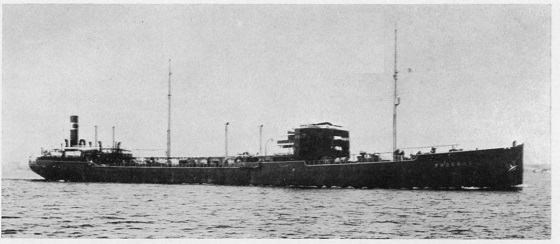
The Phoebus was built by Howaldtswerke, Kiel during 1923 for the Deutsche Amerikanische Petroleum Gesellschaft, (DAPAG) Hamburg (or German American Petroleum Company). DAPAG was a German affiliate of ESSO (originally known as the Standard Oil Company of New Jersey), one of the companies created following the ruling by the Supreme Court of the United States that ordered the dissolving of Standard Oil Company.
The ship was launched during February 1923 and completed during August 1923.
By October 1927 the Jersey fleet and its affiliates consisted of 92 tankers, with the Phoebus and twelve other tankers under the Baltisch-Amerikanische (BAPICO) registry based in the free city of Danzig.
The tanker Phoebus travelled through the troubled pages of history without itself becoming headline news, but during April 1933 it became part of the story surrounding the loss of the dirigible USS Akron (ZRS-4). The USS Akron was operating along the coast of New England assisting in the calibration of radio direction finder stations. Having departed Lakehurst, New Jersey severe weather was already affecting the Akron as she passed the Barnegat Light, New Jersey at 10pm on April 3rd. The worsening weather, in particular the very strong wind gusts became a serious problem in the control of the Akron. About thirty minutes after midnight the wind pushed the Akron into the Atlantic, crashing tail first before disappeaing under the waves. Nearby the tanker Phoebus had seen the Akron's lights descending toward the ocean and altered course to starboard to investigate, assuming an aeroplane was in trouble. At 12.55am the Phoebus pulled Lieutenant Commander Herbert V. Wiley, Akron's executive officer from the water, whilst the ship's boat picked up three more men. Of the seventy seven men on the Akron these were the only ones to be rescued alive, regretably one of the rescued would succumb whilst on the Phoebus.
The boats of the Phoebus searched the area for survivors for five hours without success. About dawn the United States Coast Guard cutter Tucker (CG-23) arrived, the first of several ships hurrying to the area. The survivors were transferred to the Tucker from the Phoebus, which then returned to its regular voyage.
On May 31st 1935, with growing concern over Nazi intentions in Europe, the entire BAPICO fleet was transferred from Danzig, Germany to Panamanian registry, creating the Panama Transportation Company (PTC) as an affiliate. These ships continued to be manned by German crews
With the political situation deteriorating in Europe the German crews manning the PTC ships were replaced as the vessels visited American ports, by August 31st 1939 the German crews of 16 of the 27 ships had been replaced. It was an increasing challenge for the laid off German crews to return to Germany. During January 1940 some of these men would be part of the reason in the stopping of the Asama Maru on the high seas by a British warship. The Phoebus had arrived in Hamburg, Germany on August 16th 1939 still manned by a German crew. The ship was to be held for two months to allow for repairs. The Phoebus departed Hamburg on October 17th 1939, manned by a Danish crew and headed for Kirkwall (October 27th) and reaching Aruba on November 17th. The ship's cargo included 150 tons of spare parts for other PTC ships, two launches and a small tow boat.
The neutral registry of the Panama Transportation Company permitted the PTC ESSO tankers to deliver petroleum products to Great Britain and France. The neutrality act of November 1st 1939 had placed restrictions on American flagged ships operating in Europe.
Between November 1939 and June 1941 the Phoebus travelled between the Eastern Seaboard, the Carribean and Brazil & Argentina, visiting Aruba, Santos, Rio De Janeiro, Caripito, Boston, New York, Buenos Aires, Campana (Argentina) and Pernambuco.
From June 1941 to June 1942 the sailings to Brazil and Argentina were discontinued, now operating along the Eastern Seaboard and the Carribean, including New York, Philadelphia, Aruba, Hampton Roads, Caripito, Pernambuco, Hampton Roads, Bermuda and Trinidad.
Between July 1942 and August 1945 the Phoebus operated either in convoys or independently on the Eastern Seaboard and Carribean routes, visiting Baytown, Texas City, Baltimore, Port Everglades, Lake Charles, Corpus Christi, Boston, Halifax, Portland, Charleston, Guantanamo, Trinidad, Caripito, Curacao, Key West, New York City, Galveston Bar, Hampton Roads, Brownsville and New Orleans.
Following the end of World War Two the Phoebus continued its sailings between the ports of the Eastern Seaboard and the Caribbean.
The Phoebus was broken up at Baltimore during the third quarter of 1950 by the Patapsco Scrap Company.
Sister ships: Vistula & Prometheus.
Built: Howaldtswerke, Kiel (#625)
Launched: February 1923
Tonnage: 9,226 grt tons, ?? net
Deadweight: 14,000 tons
Length: 500 ft
Breadth: 64 ft
Draught: 39 ft 4 in
Propulsion: 2 x 4ST68 diesel engines producing 3,400hp at 90rpm; built by Sulzer, Ludwigshafen.
Auxiliary engines: 2 x 4SS34 diesel engines producing 820hp at 200rpm.
Screws:2
Speed: 11.7 knots
ID Number: 5605961
Resources
Arnold Hague's Database - Convoyweb
Auke Visser's International Esso Tankers site
Page added January 11th 2012.
Last updated October 25th 2015.
Return to Ship menu
Return to site menu